State of the Art of Desalination in Mexico
Abstract
1. Introduction
- The evolution of desalination in Mexico is analyzed in terms of its total capacity and percentages by technology.
- The main contributions and findings of R&D of Desalination in Mexico are reported.
- The main limitations for desalination in Mexico to be a sustainable solution to overcome water stress are defined.
- An overview of existing and ongoing regulations is given, as well as program and policy options proposed by the authors.
2. Current State of Desalination in Mexico
2.1. Water Availability in Mexico
2.2. Desalination Plants in Mexico
2.2.1. Reverse Osmosis
2.2.2. Electrodialysis
2.2.3. Electrodeionization (EDI)
2.2.4. Multi-Stage Flash
2.2.5. Multiple-Effect Distillation (MED)
2.2.6. Vapor Compression (VC)
2.3. Social, Economic, and Legislative Scenario for Desalination in Mexico
2.3.1. Social
2.3.2. Economic
2.3.3. Legislative
3. Mexico’s Research and Development in Desalination
3.1. Membrane Technologies
3.1.1. Reverse Osmosis (RO)
3.1.2. Electrodialysis (ED)
3.1.3. Nanofiltration (NF)
3.1.4. Electrodeionization (EDI)
3.2. Phase Change Technologies
3.2.1. Multi-Stage Flash
3.2.2. MED
3.2.3. Humidificación-Deshumidificación (HDH)
3.2.4. Solar Still
4. Conclusions, Outlook, and Future Challenges of Desalination in Mexico
- Academy–Industry–Government joint participation.
- The improvement of the infrastructure of water transport/distribution networks to avoid water waste.
- Spatial homogenization of industrial activity to reduce consumption in water-stressed areas and increase GDP in the southeast regions.
- The implementation of new desalination plants powered by renewable energy in areas with energy deficits, primarily in remote communities.
- The value of water through rate increases or penalties in cases of excessive consumption and/or in the event that water is used for purposes other than those previously established.
- Seeking the sustainability of the virtual transfer of water carried out through the export of agricultural and industrial products.
Author Contributions
Funding
Data Availability Statement
Conflicts of Interest
References
- Damania, R.; Desbureaux, S.; Hyland, M.; Islam, A.; Moore, S.; Rodella, A.-S.; Russ, J.; Zaveri, E. The New Economics of Water Scarcity and Variability; World Bank Group, 2017. Available online: https://openknowledge.worldbank.org/bitstream/handle/10986/28096/9781464811791.pdf?sequence=21&isAllowed=y (accessed on 12 April 2022).
- Cosgrove, W.J.; Loucks, D.P. Water management: Current and future challenges and research directions. Water Resour. Res. 2015, 51, 4823–4839. [Google Scholar] [CrossRef]
- UNESCO. Agua y Cambio Climático. 2020. Available online: www.unesco.org/open-access/ (accessed on 11 April 2022).
- Boriskina, S.V.; Raza, A.; Zhang, T.; Wang, P.; Zhou, L.; Zhu, J. Nanomaterials for the water-energy nexus. MRS Bull. 2019, 44, 59–66. [Google Scholar] [CrossRef]
- Delyannis, E. Historic background of desalination and renewable energies. Sol. Energy 2003, 75, 357–366. [Google Scholar] [CrossRef]
- do Thi, H.T.; Pasztor, T.; Fozer, D.; Manenti, F.; Toth, A.J. Comparison of desalination technologies using renewable energy sources with life cycle, pestle, and multi-criteria decision analyses. Water 2021, 13, 3023. [Google Scholar] [CrossRef]
- Goh, P.S.; Kang, H.S.; Ismail, A.F.; Hilal, N. The hybridization of thermally-driven desalination processes: The state-of-the-art and opportunities. Desalination 2021, 506, 115002. [Google Scholar] [CrossRef]
- DesalData. GWI/DESALDATA. 2022. Available online: https://www.desaldata.com/ (accessed on 21 April 2022).
- Jones, E.; Qadir, M.; van Vliet, M.T.H.; Smakhtin, V.; Kang, S.-M. The state of desalination and brine production: A global outlook. Sci. Total Environ. 2019, 657, 1343–1356. [Google Scholar] [CrossRef]
- Zotalis, K.; Dialynas, E.G.; Mamassis, N.; Angelakis, A.N. Desalination technologies: Hellenic experience. Water 2014, 6, 1134–1150. [Google Scholar] [CrossRef]
- Catrini, P.; Cipollina, A.; Giacalone, F.; Micale, G.; Piacentino, A.; Tamburini, A. Thermodynamic, Exergy, and Thermoeconomic analysis of Multiple Effect Distillation Processes. In Renewable Energy Powered Desalination Handbook: Application and Thermodynamics; Elsevier Inc.: Amsterdam, The Netherlands, 2018; pp. 445–489. [Google Scholar] [CrossRef]
- Eke, J.; Yusuf, A.; Giwa, A.; Sodiq, A. The global status of desalination: An assessment of current desalination technologies, plants and capacity. Desalination 2020, 495, 114633. [Google Scholar] [CrossRef]
- Thu, K.; Kim, Y.D.; Amy, G.; Chun, W.G.; Ng, K.C. A hybrid multi-effect distillation and adsorption cycle. Appl. Energy 2013, 104, 810–821. [Google Scholar] [CrossRef]
- Dévora-Isiordia, G.E.; González-Enríquez, R.; Ruiz-Cruz, S. Evaluación de procesos de desalinización y su desarrollo en México. Tecnol. Cienc. Agua 2013, IV, 27–46. [Google Scholar]
- López-Zavala, R.; Velázquez, N.; González-Uribe, L.A.; Quezada-Espinoza, K.M.; Aguilar-Jiménez, J.A.; Islas, S.; Nakasima-López, M.; González, E. Absorption cooling and desalination system with a novel internal energetic and mass integration that increases capacity and efficiency. Desalination 2019, 471, 114144. [Google Scholar] [CrossRef]
- Qasem, N.A.A.; Zubair, S.M. Performance evaluation of a novel hybrid humidification-dehumidification (air-heated) system with an adsorption desalination system. Desalination 2019, 461, 37–54. [Google Scholar] [CrossRef]
- Velázquez-Limón, N.; López-Zavala, R.; Hernández-Callejo, L.; Aguilar-Jiménez, J.A.; Ojeda-Benítez, S.; Ríos-Arriola, J. Study of a Hybrid Solar Absorption-Cooling and Flash-Desalination System. Energies 2020, 13, 3943. [Google Scholar] [CrossRef]
- Ghenai, C.; Kabakebji, D.; Douba, I.; Yassin, A. Performance analysis and optimization of hybrid multi-effect distillation adsorption desalination system powered with solar thermal energy for high salinity sea water. Energy 2021, 215, 119212. [Google Scholar] [CrossRef]
- Soomro, M.I.; Kim, W.S. Performance and economic evaluation of linear Fresnel reflector plant integrated direct contact membrane distillation system. Renew. Energy 2018, 129, 561–569. [Google Scholar] [CrossRef]
- Mata-Torres, C.; Zurita, A.; Cardemil, J.M.; Escobar, R.A. Exergy cost and thermoeconomic analysis of a Rankine Cycle + Multi-Effect Distillation plant considering time-varying conditions. Energy Convers. Manag. 2019, 192, 114–132. [Google Scholar] [CrossRef]
- Aguilar-Jiménez, J.A.; Velázquez, N.; López-Zavala, R.; Beltrán, R.; Hernández-Callejo, L.; González-Uribe, L.A.; Alonso-Gómez, V. Low-temperature multiple-effect desalination/organic Rankine cycle system with a novel integration for fresh water and electrical energy production. Desalination 2020, 477, 114269. [Google Scholar] [CrossRef]
- INEGI. Así se contó México. 2021. Available online: https://www.inegi.org.mx/contenidos/productos/prod_serv/contenidos/espanol/bvinegi/productos/nueva_estruc/702825007046.pdf (accessed on 26 April 2022).
- CONAGUA (Comisión Nacional del Agua). Compendio Básico del Agua en México 1999. 1999. Available online: https://www.gob.mx/cms/uploads/attachment/file/259364/_1999_CBA1999.pdf (accessed on 7 April 2022).
- Plummer, J.; Ratcliffe Illustrations, L.; Hambre, D. Fao Office for Corporate Communication. 2017. Available online: www.fao.org/publications (accessed on 29 April 2022).
- Falkenmark, M.; Lindh, G. How Can We Cope with the Water Resources Situation by the Year 2015? Ambio 1974, 3, 114–122. Available online: http://www.jstor.org/stable/4312063 (accessed on 20 September 2022).
- Xu, H.; Wu, M. Water Availability Indices—A Literature Review. 2017. Available online: www.anl.gov (accessed on 2 May 2022).
- Manungufala, T. Water Scarcity: Classification, Measurement and Management. 2021, pp. 1–14. Available online: https://www.researchgate.net/publication/350070501_Water_Scarcity_Classification_Measurement_and_Management (accessed on 23 April 2022).
- CONAGUA (Comisión Nacional del Agua). Estadísticas del Agua en México. 2019. Available online: https://sina.conagua.gob.mx/publicaciones/EAM_2019.pdf (accessed on 21 April 2022).
- CONAGUA (Comisión Nacional del Agua). Numeragua; México 2018. Available online: https://sina.conagua.gob.mx/publicaciones/Numeragua_2018.pdf (accessed on 9 April 2022).
- Breña Naranjo, A. Seguridad hídrica en tiempos de sequía. Perspect. IMTA 2021, 1–42. [Google Scholar] [CrossRef]
- Garg, K.; Das, S.K.; Tyagi, H. Thermal design of a humidification-dehumidification desalination cycle consisting of packed-bed humidifier and finned-tube dehumidifier. Int. J. Heat Mass Transf. 2022, 183, 122153. [Google Scholar] [CrossRef]
- Rahimi-Ahar, Z.; Hatamipour, M.S.; Ahar, L.R. Air Humidification-Dehumidification Process for Desalination: A review. Prog. Energy Combust. Sci. 2020, 80, 100850. [Google Scholar] [CrossRef]
- Roggenburg, M.; Warsinger, D.M.; Bocanegra Evans, H.; Castillo, L. Combatting water scarcity and economic distress along the US-Mexico border using renewable powered desalination. Appl. Energy 2021, 291, 116765. [Google Scholar] [CrossRef]
- Ramírez, A.; Viveros, J.M. Brewing with Cannabis sativa vs. Humulus lupulus: A review. J. Inst. Brew. 2021, 127, 201–209. [Google Scholar] [CrossRef]
- INEGI. Anuario Estadístico y Geográfico por Entidad Federativa 2020. 2020. Available online: https://www.inegi.org.mx/contenidos/productos/prod_serv/contenidos/espanol/bvinegi/productos/nueva_estruc/702825197513.pdf (accessed on 9 April 2022).
- Han, D.; He, W.F.; Yue, C.; Pu, W.H. Study on desalination of zero-emission system based on mechanical vapor compression. Appl. Energy 2017, 185, 1490–1496. [Google Scholar] [CrossRef]
- CONAGUA (Comisión Nacional del Agua). Programa Nacional Hídrico. 2018. Available online: https://www.gob.mx/cms/uploads/attachment/file/642632/PNH_2020-2024__ptimo.pdf (accessed on 14 April 2022).
- Tzanakakis, V.A.; Paranychianakis, N.V.; Angelakis, A.N. Water supply and water scarcity. Water 2020, 12, 2347. [Google Scholar] [CrossRef]
- Elimelech, M.; Phillip, W.A. The Future of Seawater Desalination: Energy, Technology, and the Environment. 2011, Volume 333. Available online: http://science.sciencemag.org/ (accessed on 26 April 2022).
- McEvoy, A.; Perdue Publisher, J. Desalination and Development: The Socioecological and Technological Transformation of the Gulf of California; The University of Arizona: Tucson, AZ, USA, 2013; Available online: http://hdl.handle.net/10150/301684 (accessed on 20 September 2022).
- USTDA (US Trade and Development Agency). Puerto Peñasco Seawater Desalination Facility Feasibility Study (Final Report, Public Version); Prepared by the Joint Team Comprised of Trussel Technologies; W.L. Bouchard and Associates, Inc.: Fredericksburg, VA, USA, 2009.
- PROY-NOM-013-CONAGUA-2015, Que establece Especificaciones y Requisitos para las obras de Toma y Descarga que se deben Cumplir en las Plantas Desalinizadoras o Procesos que Generen aguas de Rechazo Salobres o Salinas. Available online: https://www.cmic.org.mx/comisiones/Sectoriales/infraestructurahidraulica/Normas/Seguimiento_CMIC_en_las_Normas/NOM_3_Plantas_Desalinizadoras/15_reunion/PROY-NOM-013-CONAGUA-2015%20c.pdf (accessed on 6 April 2022).
- Meerganz von Medeazza, G.L. “Direct” and socially-induced environmental impacts of desalination. Desalination 2005, 185, 57–70. [Google Scholar] [CrossRef]
- Wilder, M.O.; Aguilar-Barajas, I.; Pineda-Pablos, N.; Varady, R.G.; Megdal, S.B.; McEvoy, J.; Merideth, R.; Zúñiga-Terán, A.A.; Scott, C.A. Desalination and water security in the US–Mexico border region: Assessing the social, environmental and political impacts. Water Int. 2016, 41, 756–775. [Google Scholar] [CrossRef]
- CONAGUA (Comisión Nacional del Agua). Strategic Projects. Mexico: National Infrastructure Program. 2015. Available online: http://www.conagua.gob.mx/CONAGUA07/Noticias/SeguimientoPNI.pdf (accessed on 7 March 2022).
- NORMA Oficial Mexicana NOM-001-SEMARNAT-2021, Que Establece los Límites Permisibles de Contaminantes en las Descargas de Aguas Residuales en Cuerpos Receptores Propiedad de la Nación. Diario Oficial de la Federación (DOF). Available online: https://www.dof.gob.mx/nota_detalle.php?codigo=5645374&fecha=11/03/2022#gsc.tab=0 (accessed on 26 September 2022).
- NORMA Oficial Mexicana NOM-003-CONAGUA-1996, Requisitos Durante la Construcción de pozos de Extracción de agua para Prevenir la Contaminación de Acuíferos. Diario Oficial de la Federación (DOF). Available online: https://www.conagua.gob.mx/conagua07/contenido/documentos/NOM-003-CONAGUA-1996.pdf (accessed on 26 September 2022).
- NORMA Oficial Mexicana NOM-006-ENER-2015, Eficiencia Energética Electromecánica en Sistemas de Bombeo para pozo Profundo en Operación. Límites y Método de Prueba. Diario Oficial de la Federación (DOF). Available online: https://dof.gob.mx/nota_detalle.php?codigo=5393140&fecha=21/05/2015#gsc.tab=0 (accessed on 26 September 2022).
- NORMA Oficial Mexicana NOM-127-SSA1-1994, Salud Ambiental, agua para uso y Consumo Humano-Límites Permisibles de Calidad y Tratamientos a que debe Someterse el agua para su Potabilización. Diario Oficial de la Federación (DOF). Available online: http://www.ordenjuridico.gob.mx/Documentos/Federal/wo69543.pdf (accessed on 26 September 2022).
- Zarzo, D.; Prats, D. Desalination and energy consumption. What can we expect in the near future? Desalination 2018, 427, 1–9. [Google Scholar] [CrossRef]
- Web of Science (WOS). Citation Report Graphic Is Derived from Clarivate Web of Science, Copyright Clarivate 2022. All Rights Reserved. Available online: https://www.webofscience.com/wos/woscc/citation-report/d5a41cc5-1d6a-4252-8f3b-6b500aae647a-5b7be06a (accessed on 15 April 2022).
- Armendáriz-Ontiveros, M.M.; Álvarez-Sánchez, J.; Dévora-Isiordia, G.E.; García, A.; Fimbres Weihs, G.A. Effect of seawater variability on endemic bacterial biofouling of a reverse osmosis membrane coated with iron nanoparticles (FeNPs). Chem. Eng. Sci. 2020, 223, 115753. [Google Scholar] [CrossRef]
- Murillo Verduzco, I.; Herrera Sarellano, M.; Figueroa Diaz, R.A.; Fimbres Weihs, G.A.; Castro Quintero, R.A. Design and Manufacturing of a Pulsatile Valve for Generating Variable Flows in Reverse Osmosis Desalination Modules. DYNA 2020, 95, 509–513. [Google Scholar] [CrossRef]
- Kitano, H.; Takeuchi, K.; Ortiz-Medina, J.; Ito, I.; Morelos-Gomez, A.; Cruz-Silva, R.; Yokokawa, T.; Terrones, M.; Yamaguchi, A.; Hayashi, T.; et al. Enhanced desalination performance in compacted carbon-based reverse osmosis membranes. Nanoscale Adv. 2020, 2, 3444–3451. [Google Scholar] [CrossRef] [PubMed]
- Feria-Díaz, J.J.; Correa-Mahecha, F.; López-Méndez, M.C.; Rodríguez-Miranda, J.P.; Barrera-Rojas, J. Recent desalination technologies by hybridization and integration with reverse osmosis: A review. Water 2021, 13, 1369. [Google Scholar] [CrossRef]
- Rodríguez-López, J.; Robles-Lizárraga, A.; Encinas-Guzmán, M.I.; Correa-Díaz, F.; Dévora-Isiordia, G.E. Assessment of fixed, single-axis, and dual-axis photovoltaic systems applied to a reverse osmosis desalination process in Northwest Mexico. Desalination Water Treat. 2021, 234, 399–407. [Google Scholar] [CrossRef]
- Torres-Valenzuela, P.G.; Álvarez-Sánchez, J.; Dévora-Isiordia, G.E.; Armendáriz-Ontiveros, M.M.; del Rosario Martínez-Macias, M.; Pérez-Sicairos, S.; Sánchez-Duarte, R.G.; Fimbres Weihs, G.A. Modification and characterization of TFC membranes with Ag nanoparticles: Application in seawater desalination. Polym. Bull. 2022. [Google Scholar] [CrossRef]
- Lambert, J.; Rakib, M.; Durand, G.; Avila-Rodríguez, M. Treatment of solutions containing trivalent chromium by electrodialysis. Desalination 2006, 191, 100–110. [Google Scholar] [CrossRef]
- Ortega, A.; Oliva, I.; Contreras, K.E.; González, I.; Cruz-Díaz, M.R.; Rivero, E.P. Arsenic removal from water by hybrid electro-regenerated anion exchange resin/electrodialysis process. Sep. Purif. Technol. 2017, 184, 319–326. [Google Scholar] [CrossRef]
- Arreola-Castro, M.; Rojas-Montes, J.C.; Martínez-Gómez, V.J.; Calla-Choque, D.; Rodríguez-Rosales, M.J.; Pérez-Garibay, R.; Valencia-Vázquez, R. Electrodialysis applied to the removal of iron ions in an aqueous solution. Rev. Mex. Ing. Quim. 2021, 20, 775–786. [Google Scholar] [CrossRef]
- Enciso, R.; Delgadillo, J.A.; Domínguez, O.; Rodríguez-Torres, I. Analysis and validation of the hydrodynamics of an electrodialysis cell using computational fluid dynamics. Desalination 2017, 408, 127–132. [Google Scholar] [CrossRef]
- Dévora-Isiordia, G.E.; Ayala-Espinoza, A.; Lares-Rangel, L.A.; Encinas-Guzmán, M.I.; Sánchez-Duarte, R.G.; Álvarez-Sánchez, J.; Martínez-Macías, M.D.R. Effect of temperature on diluate water in batch electrodialysis reversal. Separations 2021, 8, 229. [Google Scholar] [CrossRef]
- Perez-Moreno, V.; Bonilla-Suarez, C.B.; Rodriguez-Muñoz, M.E. Seawater desalination in Mexican Pacific coast by a new technology: Use and perspectives. Desalination Water Treat. 2013, 51, 175–183. [Google Scholar] [CrossRef]
- Flores-Prieto, J.J.; Ramírez-Luna, J.J.; Calderón-Mólgora, C.G.; Delgado-Quezada, E.; Morales-García, A.J. Solar Brackish Water Treatment for Irrigation Using Low-Pressure Nanofiltration. Water Technol. Sci. 2015, VI, 5–17. [Google Scholar]
- García-Picazo, F.J.; Pérez-Sicairos, S.; Fimbres-Weihs, G.A.; Lin, S.W.; Salazar-Gastélum, M.I.; Trujillo-Navarrete, B. Preparation of thin-film composite nanofiltration membranes doped with n-and cl-functionalized graphene oxide for water desalination. Polymers 2021, 13, 1637. [Google Scholar] [CrossRef] [PubMed]
- Ounifi, I.; Guesmi, Y.; Ursino, C.; Castro-Muñoz, R.; Agougui, H.; Jabli, M.; Hafiane, A.; Figoli, A.; Ferjani, E. Synthesis and Characterization of a Thin-Film Composite Nanofiltration Membrane Based on Polyamide-Cellulose Acetate: Application for Water Purification. J. Polym. Environ. 2022, 30, 707–718. [Google Scholar] [CrossRef]
- Alvarado, L.; Ramírez, A.; Rodríguez-Torres, I. Cr(VI) removal by continuous electrodeionization: Study of its basic technologies. Desalination 2009, 249, 423–428. [Google Scholar] [CrossRef]
- Alvarado, L.; Torres, I.R.; Chen, A. Integration of ion exchange and electrodeionization as a new approach for the continuous treatment of hexavalent chromium wastewater. Sep. Purif. Technol. 2013, 105, 55–62. [Google Scholar] [CrossRef]
- Huang, W.; Zhang, Y.; Bao, S.; Cruz, R.; Song, S. Desalination by capacitive deionization process using nitric acid-modified activated carbon as the electrodes. Desalination 2014, 340, 67–72. [Google Scholar] [CrossRef]
- Otero, C.; Urbina, A.; Rivero, E.P.; Rodríguez, F.A. Desalination of brackish water by electrodeionization: Experimental study and mathematical modeling. Desalination 2021, 504, 114803. [Google Scholar] [CrossRef]
- Chargoy del Valle, N.; Fernández Zayas, J.L. Destilación solar en México, 1983 a 2003. In Investigación y Desarrollo; D.R.© UNIVERSIDAD NACIONAL AUTÓNOMA DE MÉXICO: Mexico City, Mexico, 2010. [Google Scholar]
- Priego, E.; Alonso, G.; del Valle, E.; Ramirez, R. Alternatives of steam extraction for desalination purposes using SMART reactor. Desalination 2017, 413, 199–216. [Google Scholar] [CrossRef]
- Hodges, C.N.; Lewis Thompson, T.; Groh, J.E.; Sellers, W.D. The Utilization of Solar Energy in a Multiple-Effect Desalinization System. J. Appl. Meteorol. 1964, 3, 505–512. [Google Scholar] [CrossRef]
- Martín-Domínguez, I.R.; Pérez-Galindo, J.A.; Martín-Domínguez, A.; Hansen-Rodríguez, M.P. Solar distillator using humid-air and heat pipes for rural areas in Mexico. Sol. Eng. 1998, 327–332. Available online: https://www.researchgate.net/publication/281653068 (accessed on 20 September 2022).
- Tariq, R.; Sheikh, N.A.; Xamán, J.; Bassam, A. An innovative air saturator for humidification-dehumidification desalination application. Appl. Energy 2018, 228, 789–807. [Google Scholar] [CrossRef]
- Alvarez, A.; Carranza, F.; Zavala, I.; Sauceda, D. Theoretical investigation of a direct-contact humidification-dehumidification desalination system. Desalination Water Treat. 2019, 142, 11–23. [Google Scholar] [CrossRef]
- Aguilar Castro, J. Diseño y Construcción de un Destilador Solar con Condensación por Separado; CICESE: Ensenada, Mexico, 2021. [Google Scholar]
- Feria-Díaz, J.J.; López-Méndez, M.C.; Ortiz-Monterde, L.; Médina-Salgado, B.A.; Perez-Rosas, N.C. Performance Evaluation of Solar Still in Veracruz, Mexico Gulf Coastline. Water 2022, 14, 1567. [Google Scholar] [CrossRef]
- Smith, G.; Bayldon Block, L.; Ajami, N.; Pombo, A.; Velasco-Aulcy, L. Trade-offs across the water-energy-food nexus: A triple bottom line sustainability assessment of desalination for agriculture in the San quintín Valley, Mexico. Environ. Sci. Policy 2020, 114, 445–452. [Google Scholar] [CrossRef]
- Elasaad, H.; Bilton, A.; Kelley, L.; Duayhe, O.; Dubowsky, S. Field evaluation of a community scale solar powered water purification technology: A case study of a remote Mexican community application. Desalination 2015, 375, 71–80. [Google Scholar] [CrossRef]
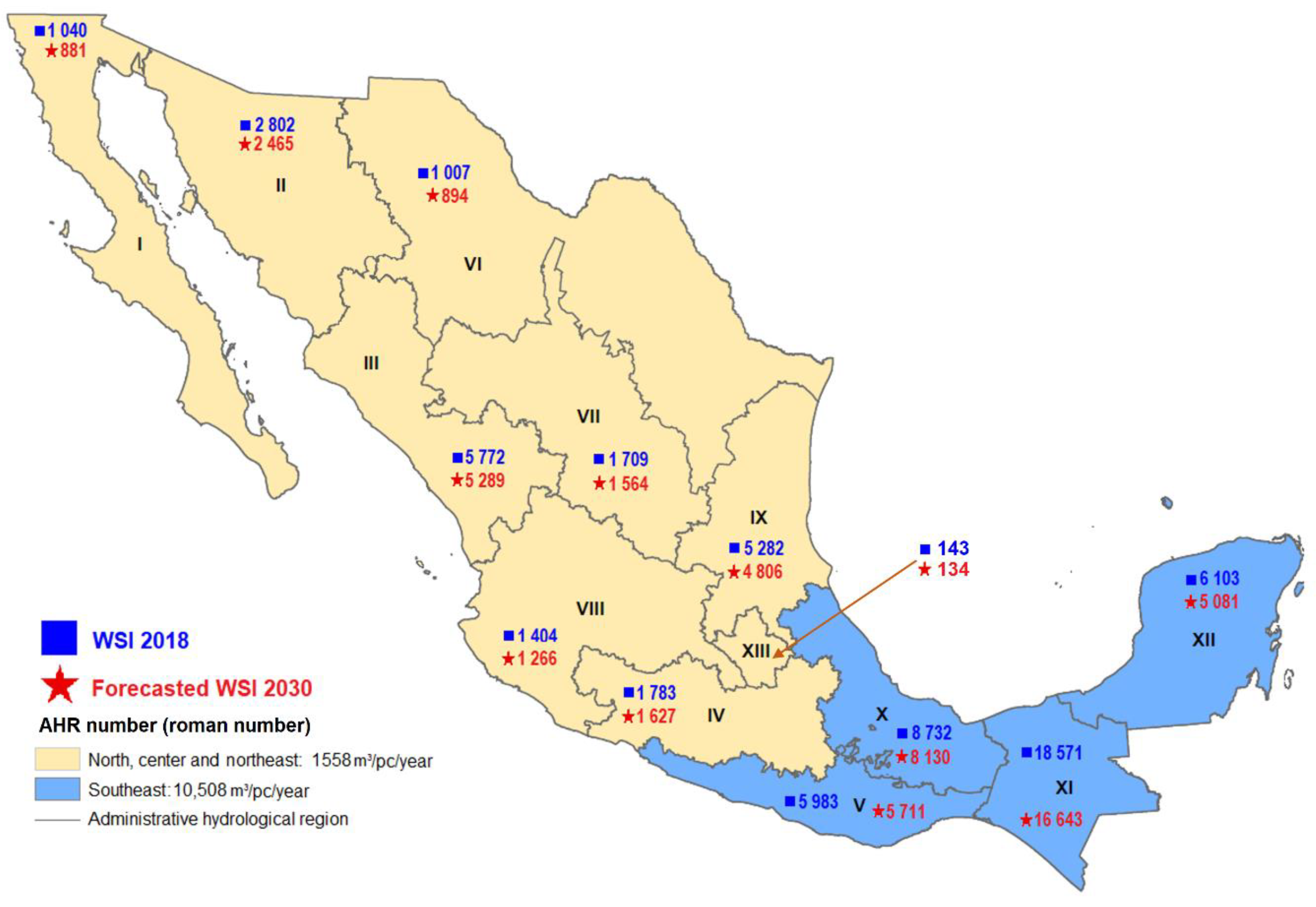
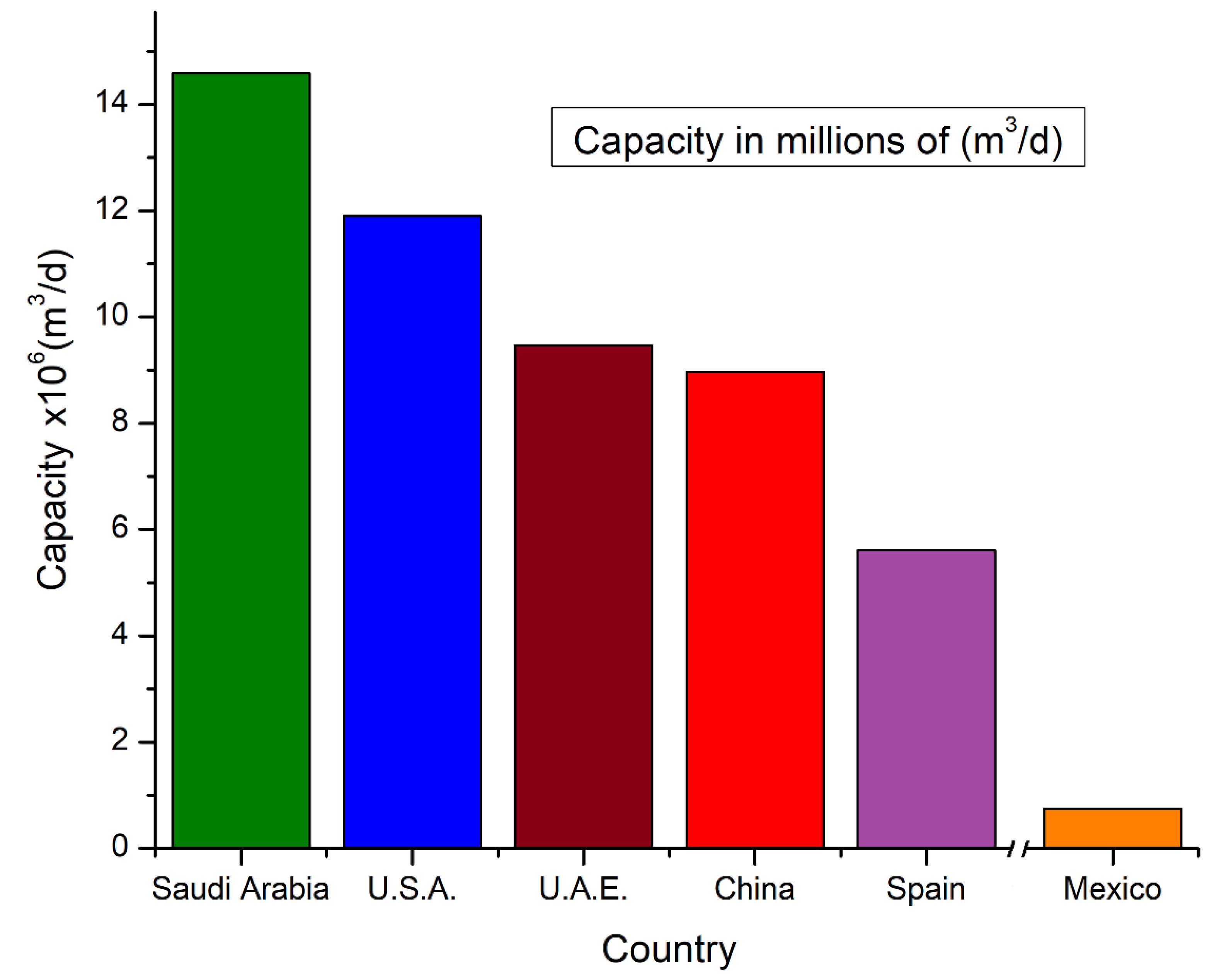
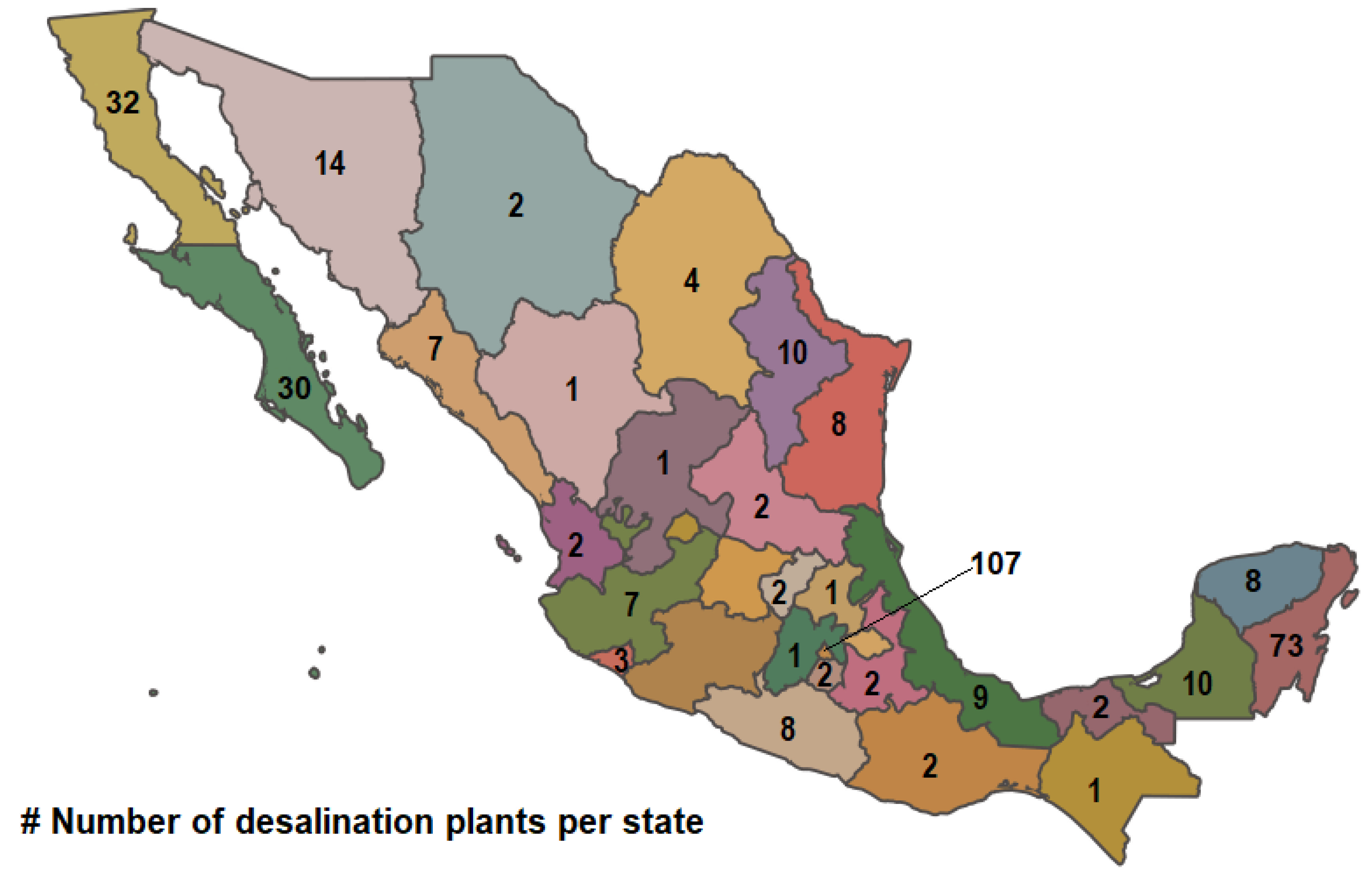
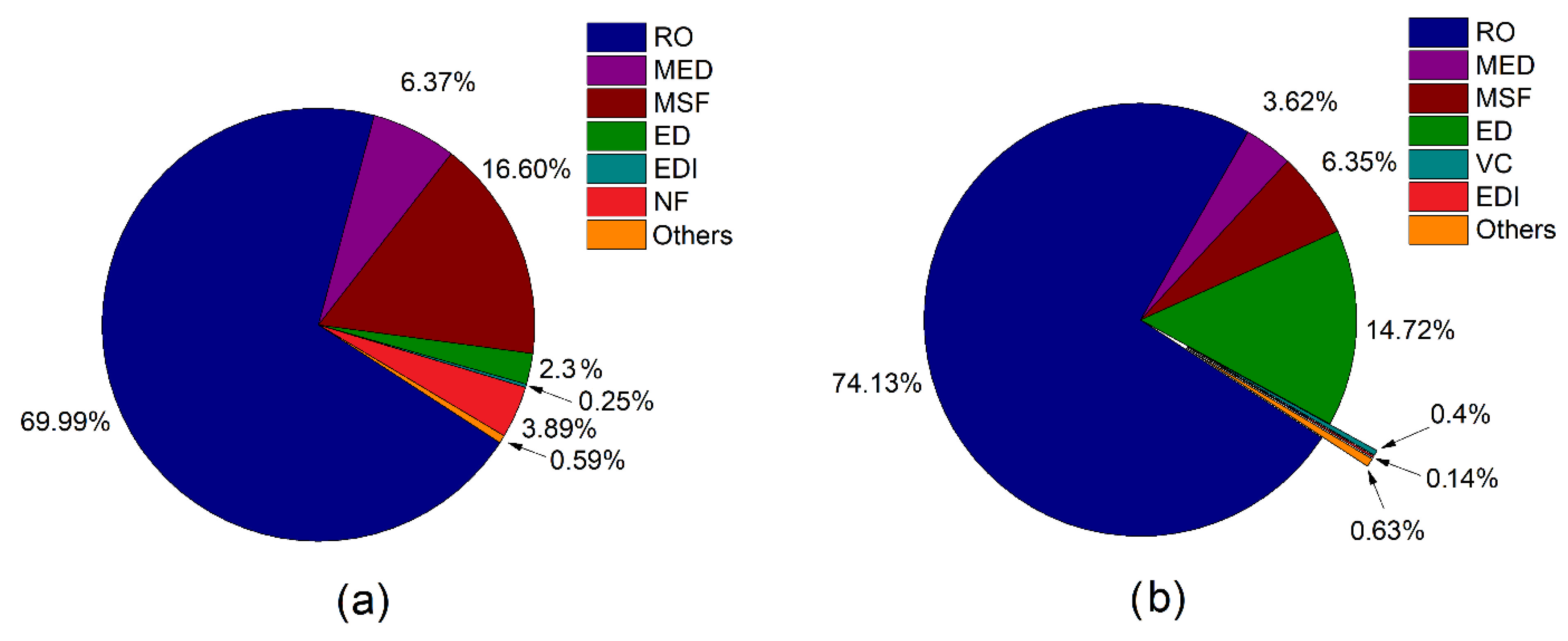
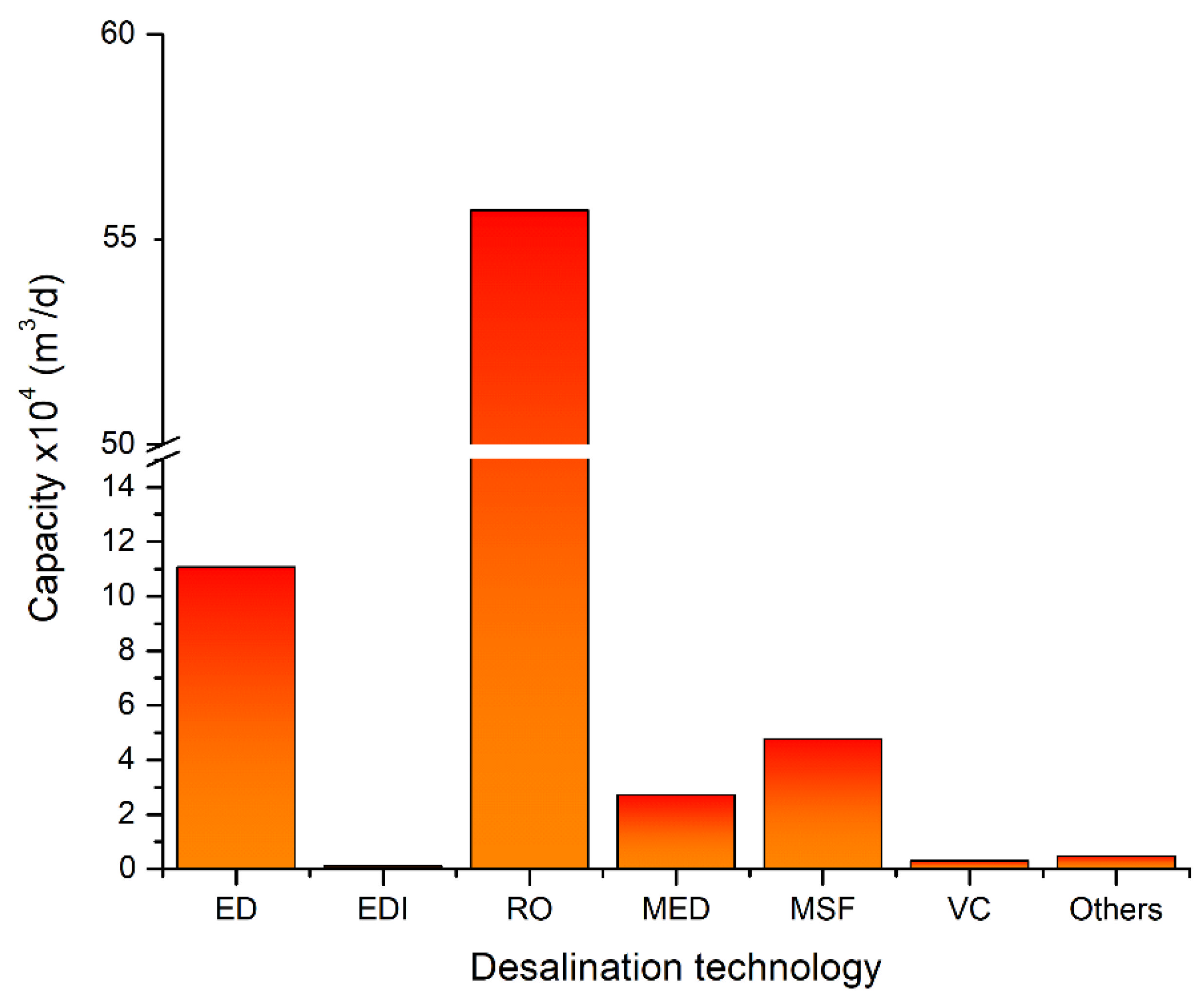
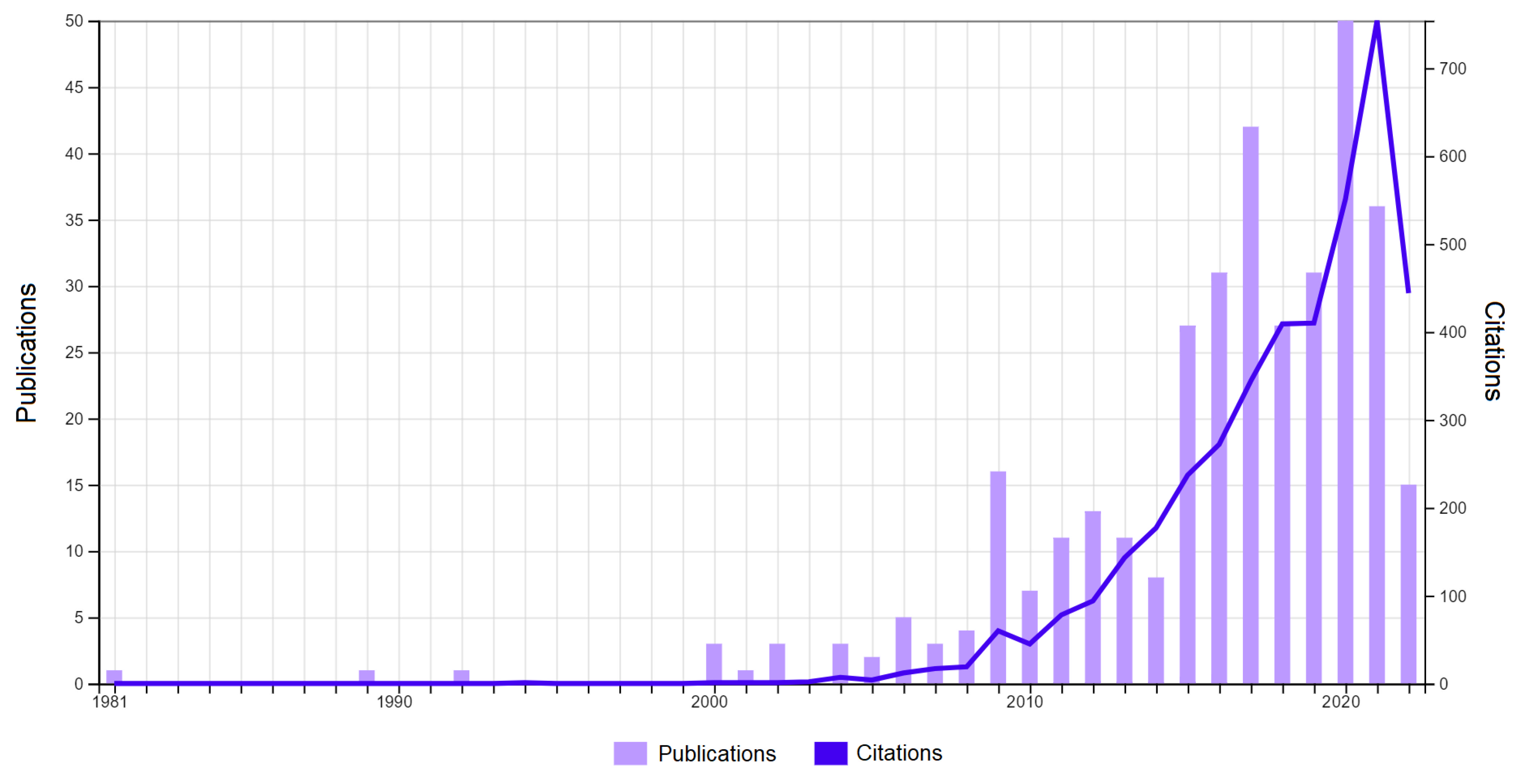
| WSI (m3/pc/Year) | Category |
|---|---|
| WSI < 500 | Absolute scarcity |
| 500 < WSI < 1000 | Chronic scarcity |
| 1000 < WSI < 1700 | Regular scarcity |
Publisher’s Note: MDPI stays neutral with regard to jurisdictional claims in published maps and institutional affiliations. |
© 2022 by the authors. Licensee MDPI, Basel, Switzerland. This article is an open access article distributed under the terms and conditions of the Creative Commons Attribution (CC BY) license (https://creativecommons.org/licenses/by/4.0/).
Share and Cite
Ríos-Arriola, J.; Velázquez, N.; Aguilar-Jiménez, J.A.; Dévora-Isiordia, G.E.; Cásares-de la Torre, C.A.; Corona-Sánchez, J.A.; Islas, S. State of the Art of Desalination in Mexico. Energies 2022, 15, 8434. https://doi.org/10.3390/en15228434
Ríos-Arriola J, Velázquez N, Aguilar-Jiménez JA, Dévora-Isiordia GE, Cásares-de la Torre CA, Corona-Sánchez JA, Islas S. State of the Art of Desalination in Mexico. Energies. 2022; 15(22):8434. https://doi.org/10.3390/en15228434
Chicago/Turabian StyleRíos-Arriola, Juan, Nicolás Velázquez, Jesús Armando Aguilar-Jiménez, Germán Eduardo Dévora-Isiordia, Cristian Ascención Cásares-de la Torre, José Armando Corona-Sánchez, and Saúl Islas. 2022. "State of the Art of Desalination in Mexico" Energies 15, no. 22: 8434. https://doi.org/10.3390/en15228434
APA StyleRíos-Arriola, J., Velázquez, N., Aguilar-Jiménez, J. A., Dévora-Isiordia, G. E., Cásares-de la Torre, C. A., Corona-Sánchez, J. A., & Islas, S. (2022). State of the Art of Desalination in Mexico. Energies, 15(22), 8434. https://doi.org/10.3390/en15228434












